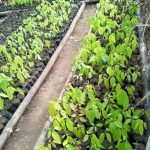Combating Desertification
With understanding over the eminent environmental challenges brought about by desertification which occurs as a result of land turning into desert as the quality of the soil declines over time, MAHSRA has been strongly involved in analytical causal assessments and pragmatic solutions provision. In order to provide support to initiatives that will bring about sustainable solutions, we assess the desertification causes of all target intervention areas. Some have been as a result of:
- The growth of the population growth in places where there are developments in mining and tourism thus providing quick job opportunities. This puts greater pressure on the zonal natural or environmental resources such as wood and water.
- Cutting down of trees with need for fuel wood makes the limited available tree roots, no longer able to hold the soil together, so it becomes more vulnerable to soil erosion.
- Overgrazing of the vegetation leaves the soil exposed to erosion. Causes of farmer grazier conflicts, see project EFCAPI
- Climate change is making the global climate is warmer, therefore, in desert regions, conditions are not only getting warmer but drier as well, thus less rain fall and intensification of the deserts.
Among our approaches to assist fight desertification and protect our natural environments, in collaboration with the Farmers Association for Creating Jobs for the Rural Youths (CORY), annual programs are conducted within several localities where nursed tree-plants and distributed to youths for planting and growing to maturity across a wide range of desertification threatening environments.
The Environment and Poverty Concerns
On 25th September 2015, 193 countries of the United Nations General Assembly adopted the 2030 agenda for Sustainable Development which contains 17 Sustainable Development Goals (SDGs).
Goal No.1 is to “End Poverty in all forms everywhere”.
Therefore global sustainable development priority is looking forward to eradicating poverty such that even the poor and vulnerable people also enjoy equal rights to economic resources, healthy living conditions as well as access to basic infrastructure and technology.
Among several reasons why poverty persists in the world, a most pertinent concern is due to lack of education and improper implementation of poverty eradication policies at the grass-root level and environmental degradation. Environmental damage can prevent people, especially the poor, from having good and hygienic living standards. It is obvious that most people living in poor communities depend mostly on the natural environmental produces for survival. While most depend on agricultural activities, environmental vulnerabilities are increased where there is lack of proper knowledge in managing sustainable farming methods.
However, proper education and capacity enhancement of the vulnerable community duelers on how to sustainably make use of their environmental subsistence opportunities may not only help to address and reduce their acute poverty situations but will also mitigate the consequential outcomes environmental problems.
To enhance the appropriate management of natural resources and soil conservative agricultural applications within communities, we provide conservative subsistence farming education, promote capacity building for community agric technicians and counselors, and create income generating farming opportunities for community youths, and other vulnerable community women and girls.














